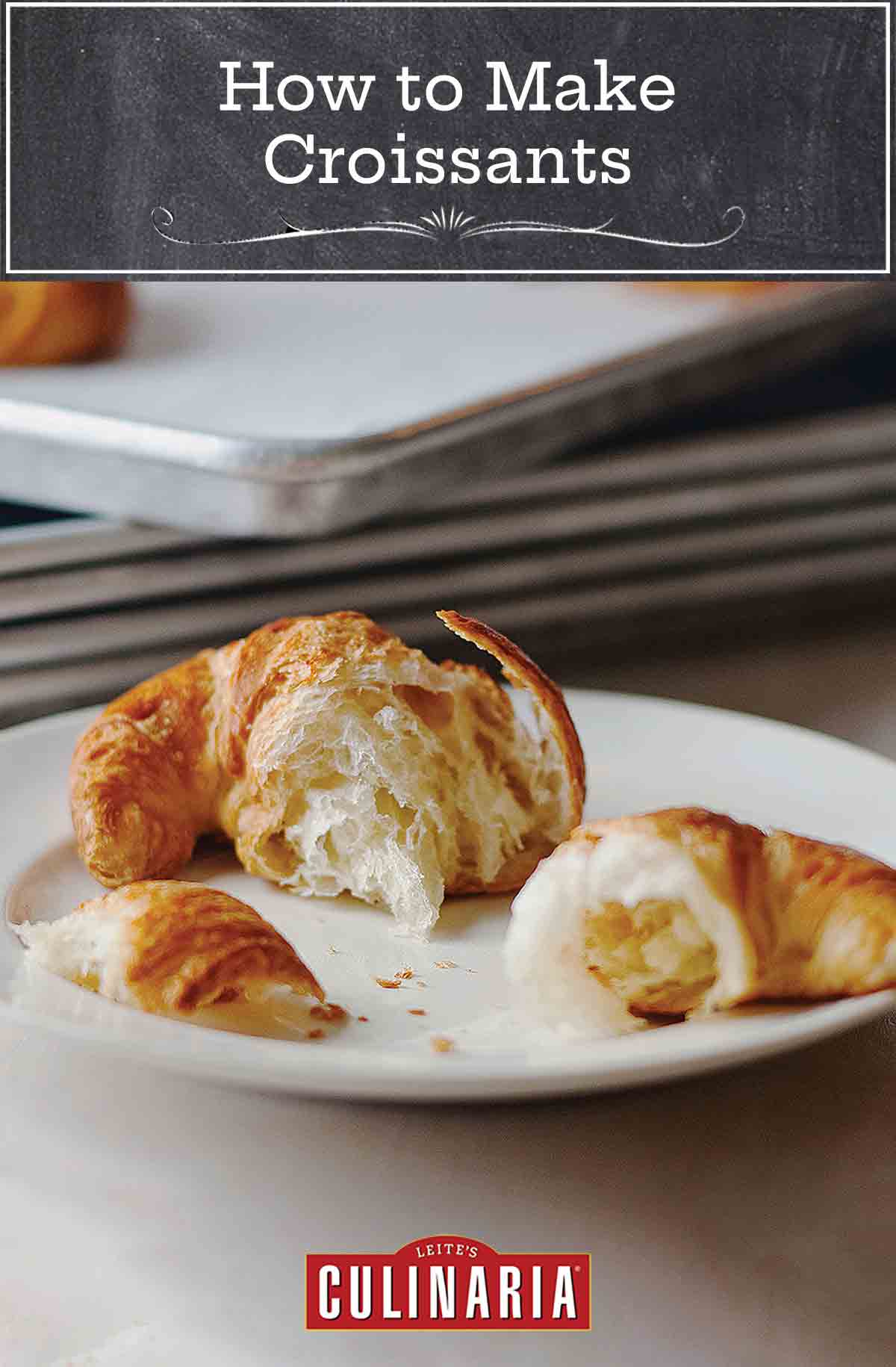
Knowing how to make croissants may or may not already be on your bucket list. Either way, you’re gonna wanna consider making these. They’re not just any croissants. They’re authentically French croissants whose outer layers seem to shatter at the merest glance and whose interior comprises layer after flaky layer of buttery goodness.
Though the recipe may appear quite long, it’s not complicated! It’s just precise. Trust us, when you’re standing at the counter with your sleeves rolled up, your cheeks smudged with flour, and this ridiculously, obscenely, ineffably buttery loveliness coming out of the oven, you’ll understand.–Sarabeth Levine and Rick Rodgers
WHAT IS LAMINATED DOUGH?
Croissants are a little fussier to make than your average pastry and that’s because they’re a laminated dough. Also because they’re French but that’s un autre histoire, bien sur. Layers and layers of butter and dough get folded together and when the heat of the oven hits those layers, the butter melts and the liquid converts to steam, puffing up all those gluten-strengthened layers. Laminated dough is seen in croissants, puff pastry, kouign amann, or palmiers—pastries where you want the lightest and flakiest dough possible. Croissants have the added benefit of yeast, making them even rise higher and giving them a more bread-like finish.

Flaky Croissants
Ingredients
For the detrempe
- 3/4 ounce (1 packed tablespoon plus 1 1/2 packed teaspoons) compressed yeast, or 2 3/4 teaspoons active dry yeast
- 1/4 cup granulated sugar
- 1 1/4 cups whole milk, cold
- 1 3/4 cups bread flour, plus more for rolling out
- 1 1/4 cups pastry or unbleached cake flour, sifted
- 1 teaspoon fine sea salt
For the beurrage
- 2 sticks (8 oz) unsalted butter, chilled and cut into tablespoons
- 2 tablespoons bread flour, plus more for the work surface
For the croissants
- Unbleached all-purpose flour, for rolling
- 1 large egg, well beaten
Instructions
Make the detrempe (a fancy word for dough)
- If using compressed yeast, finely crumble it into the bowl of a heavy-duty standing mixer. Add the sugar and let it rest until the yeast gives off some moisture, about 3 minutes. Whisk well to dissolve the yeast, then stir in the milk. If using active dry yeast, sprinkle the yeast over 1/4 cup of the milk that you've warmed to 105° F to 115° F (40°C to 46°C). Let it rest until the yeast softens and begins to foam, about 5 minutes. Whisk well to dissolve. Pour into the bowl of a heavy-duty stand mixer and then stir in the sugar. Add the remaining 1 cup cold milk.
- Mix the bread and pastry flours together. Add 2 cups of the flour mixture and the salt to the yeast mixture in the bowl. Attach the bowl to the mixer and fit it with the paddle attachment. Mix on low speed, adding enough of the remaining flour mixture as it takes to make a soft, sticky dough. Do not overmix, as the dough will be worked and absorb more flour during the rolling and folding processes.
- Move the dough to a floured work surface and knead a few times to smooth the surface. Shape the dough into a ball. The ball will hold its shape but will spread slightly as it stands.
- Dust a half-sheet pan with flour. Place the dough on the flour and use a small, sharp knife to cut an X about 1-inch (25-mm) deep in the top, marking it into quadrants. Sprinkle the top with a little flour and refrigerate.
Make the beurrage (an equally fancy word for butter)
- Clean the mixer bowl and paddle attachment. Add the butter to the bowl and beat with the paddle attachment on medium speed until the butter is almost smooth, about 30 seconds. Add the flour and continue beating until the mixture is smooth, cool, and malleable, about 30 seconds more. This is your beurrage (beurre = butter in French).
- Transfer the beurrage to a lightly floured work surface and press any remaining lumps of butter out with the heel of your hand. Shape the beurrage into a 4-inch (10-cm) square, place it on the half-sheet pan with the detrempe, and refrigerate for about 15 minutes. The detrempe and the beurrage should be the same consistency and temperature after this slight chilling.
- Flour the work surface again. Place the detrempe on the work surface with the ends of the X at approximately 2, 4, 7, and 10 o'clock positions. You will notice 4 quadrants of dough between the crosses of the X at the north, south, east, and west positions. Dust the top with flour. Using the heel of your hand, flatten and stretch each quadrant out about 2 1/2 inches (7 cm) to make a cloverleaf shape with an area in the center that is thicker than the "leaves."
- Use a rolling pin to roll each "cloverleaf" into a flap about 6-inches (15-cm) long and 5-inches (13-cm) wide, leaving a raised square in the center. Using the side of the rolling pin, press the sides of the raised area to mark the square.
- Place the butter square in the center of the cloverleaf. Gently stretch and pull the north-facing flap of dough down to cover the top and sides of the butter square, brushing away any excess flour. (This dough is very extendable and will stretch easily but you do need to be a little careful not to tear it. If you do, simply try to pat it back together again.)
- Now stretch and pull the south-facing flap up to cover the top and sides of the butter square. Turn the packet so the open ends of the square face north and south. Repeat folding and stretching the north- and south-facing flaps (originally the east and west flaps) to completely cover the butter square, making a butter-filled packet of dough about 6-inches square.
- Dust the work surface with flour. Turn the packet over so the 4 folded flaps face down with the open seam facing you. Dust the top with flour. Using a large, heavy rolling pin held at a slight angle, lightly pound the top to widen it slightly and help distribute the butter inside. Roll the dough into a 17-by-9-inch (43-by-23-cm) rectangle. Fold the dough into thirds, like a business letter, brushing away any excess flour. This is called a single turn. Roll the rectangle lightly to barely compress the layers. Transfer to a half-sheet pan and refrigerate for about 20 minutes.
- Lightly flour the work surface. Place the dough on the work surface with the long open seam facing you. Dust the top with flour. Roll out the dough into a 17-by-9-inch rectangle. Fold the right side of the dough over 2 inches (5 cm) to the left. Fold the left side of the dough over to meet the right side. Fold the dough in half vertically from left to right. This is a double turn (also known as a book turn). Roll the rectangle lightly to barely compress the layers. Return to the half-sheet pan and refrigerate for another 20 minutes.
- Repeat the last rolling and folding into a final single turn. With the long seam facing you, cut the dough in half vertically. Wrap each piece tightly in plastic wrap, then wrap again. Freeze for at least 24 hours or up to 4 days. The night before using the dough, place it in the refrigerator and let thaw overnight, about 8 hours. Once defrosted the dough will begin to rise, so make sure to roll it out immediately.
Roll the dough
- Line 2 half-sheet pans with parchment paper. Dust your work surface with flour. Place the dough on the work surface with the open seam facing you. Dust the top with flour. Using a large, heavy rolling pin, roll out the dough into a 16-by-12-inch (40-by-30-cm) rectangle. Don't press too hard; let the weight of the pin do much of the work. If you change the position of the dough while rolling it, keep track of which side contains the seam.
- Turn the packet so the seam faces you. (If you've lost track, look carefully at the sides of the dough, and you should be able to discern it, even though it's faint.) Using a pizza wheel and a yardstick or rule, neatly trim the rough edges so you have a neat rectangle. Cut in half lengthwise to make two 16-by-6-inch (40-by-15-cm) rectangles. Fold each rectangle into thirds, place on a half-sheet pan, and refrigerate, uncovered, for about 15 minutes.
Cut the croissants
- Remove the dough from the refrigerator. Working with one piece of dough at a time, unfold it on the work surface. Using a pizza wheel and a yardstick, start at the top left corner of the dough and make your way downward diagonally to make a half-triangle with a 2-inch base. Measure 3 1/2-inches (9-cm) from the top left corner of the strip and mark this point with a notch from the wheel. Cut down diagonally from the notch to meet the bottom left edge of the dough strip to make another triangle with a 3 1/2-inch base. Continue cutting, alternating directions of your diagonal cuts, to cut out 6 triangles. The last cut will yield a half-triangle with a 2-inch-wide base. Repeat with the second strip of dough to make 6 more large triangles and 2 half-triangles. You should have a total of 12 large triangles and 4 half-triangles.
Shape the croissants
- (Because a picture says a thousand words, see the slideshow above.) To shape the croissants, place a single "complete" triangle on the work surface with the base of the triangle facing you. Stretch the bottom slightly so it is about 5-inches (13-cm) wide. Pick up the triangle. With one hand, hold the dough triangle at the bottom and stretch it with your other hand until it is about 7-inches (17-cm) long. Return the triangle to the work surface. Starting at the bottom, roll up the triangle, and finish with the tip underneath the croissants on the pan. Curve the croissants by bringing the 2 ends together and then cross one end over the other, and press together. Repeat rolling the remaining dough triangles, placing them 1 1/2-inches (4-cm) apart on the pan. Overlap 2 of the half-triangles at their long sides, and press the seam together. Roll up as described for the large triangles and add to the pan. Repeat with the remaining half-triangles. [Editor's Note: Whew! You made it! Congrats!]
Proof the croissants
- Choose a warm place in the kitchen for proofing. Slip each pan into a tall plastic bag. Place a tall glass of very hot water near the center of each pan. Wave the opening of each bag to trap air and inflate it like a balloon to create “head room,” being sure that the plastic does not touch the delicate dough. Twist each bag closed. Let stand until the croissants look puffy but not quite doubled in size, 1 1/2 to 2 hours.
Bake the croissants
- Meanwhile, position racks in the center and top third of the oven and preheat to 375°F (190°C). Remove the glasses from the bags, then the pans. Lightly brush the croissants with the beaten egg. Bake for 10 minutes. Reduce the heat to 350°F (176°C) and continue baking until the croissants are crisp and golden brown, about 15 minutes longer. Serve the croissants warm or at room temperature.

Nutrition
Nutrition information is automatically calculated, so should only be used as an approximation.
Recipe Testers’ Reviews
After rereading (and rereading) the directions on how to actually shape and mold the dough into flaky croissants, I was brave enough to try it. I thought the flavors were spot on!











I can’t wait to try this recipe, I want to start now while my 2-year old is napping but I only have all-purpose flour in the house. Would the croissants be a huge failure if I only used this flour and not the cake or bread flours? Thanks and sorry for the stupid question, I’m guessing the flour is a pretty critical part of making these the most amazing croissants ever!
Angie, sorry to be responding to you past what I think is nap time. None of our testers tried it with just all-purpose flour, so I’m hesitant to say yes, especially since, as you surmised, the precise proportion of flours and their various characteristics is a pretty critical component. I could say something annoying about how the prolonged anticipation of waiting till you can run to the store will make the finished croissants all the more lovely, but I won’t. All I’ll do is ask that you let us know how the recipe worked for you as you’re dusting those flaky croissant crumbs from your keyboard…
Thank you, Renee! I did finally purchase the bread flour (sent my husband to get it) but he came back without the pastry flour, said he couldn’t find it. I decided to go ahead with the recipe anyway following the substitute for pastry flour using corn starch and all purpose flour. I had SO much fun following this recipe with my 7 year old daughter. We had a great time rolling and folding, rolling and folding then rolling and folding some more. It killed me to have to wait overnight to finish the recipe and actually bake the little angels. I haven’t actually tasted them yet…only 6 more minutes in the oven. It smells like a French bakery, the buttery dough aroma is filling the kitchen and making me salivate uncontrollably. I wish I could upload a picture—they look perfect.
I had to take a break from typing and promptly remove the croissants from the oven early. They were looking done, perfectly golden brown and slightly crispy…I’d hate to overbake them after all this hard work.
I couldn’t resist, I had to try the creations before I finished my post. OMG – the only sounds you could hear while my husband, my 7 year old daughter and my 2 year old son ate their croissants was the chomping coming from my daughters open mouth and my son saying, “mo, mo, mo” (more, more, more). Hubby loved them too. THANK YOU so much for this recipe, I am going to wow all of my friends and family with this one!
Do you mind if I post this link on Facebook?
Angie, this is quite possibly the loveliest comment we’ve ever received at Leite’s Culinaria. Thank you! I wish there was an audio clip of your family tucking into those croissants that you so carefully and patiently made for them, although the picture you paint with your words is still quite touching. We so appreciate you sharing this with us. Of course, all credit really goes to Sarabeth Levine and her book, Sarabeth’s Bakery. We just know a good recipe when we see it…and can’t help but share it.
Yes, of course, thank you to Sarabeth! I have to get my hands on her book!!
Hi! I’m making these right now–do I have to let them freeze for 24 hours and then defrost overnight or can I just freeze for a few hours and then leave in the fridge overnight? Thanks!
Hello, Ilan! I am more of a croissant consumer than I am a croissant baker, so I consulted with our resident baking expert Cindi Kruth, who is also a baking instructor and a LC recipe tester, and here are her pearls of croissant dough wisdom: “The freezing here seems intended to prevent any rise once the dough has been completed. It’s true that you work croissant dough enough in the rolling and turns to warm it nearly to rising temperature so a quick chill can be prudent. Once it begins to rise it will become harder to roll out neatly, which may cause a slight squishing of the layers. I doubt, however, a hugely noticeable variation. I’ve left dough a little too long, gotten some rise, and simply rolled it out anyway without any major trauma to the croissants or to me. Basically, the necessity is to keep the dough cold at every stage. That prevents premature rise and keeps the butter from melting into the dough. I think the latter reason is actually more important. My educated guess, I haven’t done this recipe, but I have made lots of other croissant recipes, is a shorter freeze is fine. It may be that the dough begins to rise slightly in the refrigerator overnight. It depends on how cold both the freezer and fridge are. Rolling out will deflate the dough again anyway. In any case, I don’t see that as causing much, if any, harm. If that timing works better, I’d say go ahead.” So as you see, permission granted! We’ll be looking forward to hearing how it goes…
Hi Renee! The croissants turned out so well! I wrote a step by step photo tutorial for this recipe and linked back here.
You can check it out here: http://www.ironwhisk.com/2012/08/french-croissants/
What a wonderful, step-by-step, lavishly photographed (not to mention lavishly worded) how-to, Iron Whisk! I think I can safely speak for Sarabeth when I say I’m so pleased to hear that you were inspired by the buttery goodness that she shared with us all. And we greatly appreciate you letting us know.
I LOVE THIS RECIPE!!! IS SOOOOO DELISH!!!
music to our ears, Daniela! thanks so much for letting us know